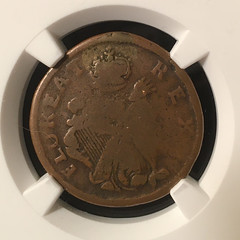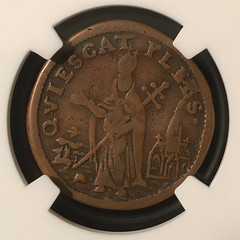
PREV ARTICLE
NEXT ARTICLE
FULL ISSUE
PREV FULL ISSUE
ACQUIRING A ST. PATRICK NEW JERSEY FARTHINGJeff Burke submitted this great story of his research and acquisition of a St. Patrick New Jersey Farthing. Thanks! Great work. -Editor Acquiring a c.1670 St. Patrick New Jersey Farthing On the night of December 19, 2022, New Jersey Numismatic Society (NJNS) members gathered at the Madison Public Library to celebrate the holiday season. We had a festive evening and enjoyed spending some time together. During the show-and-tell segment of our meeting, member Mike McKeever showed us his c.1670 St. Patrick New Jersey Farthing NGC F-12. While studying it with my magnifying glass, I asked Mike several questions about the piece. Mike described how, several years earlier, he had noticed a St. Patrick farthing listing in a Syd Martin auction catalogue. This experience piqued his interest in the St. Patrick series. Later, McKeever decided that he wanted to purchase his own specimen. He achieved a winning bid on a St. Patrick farthing in a London auction. This purchase was just one of the more recent in Mike's coin collecting pursuits, which go back over 50 years. A specialist in Papal, Swiss, Irish and Anglo-Gallic coins, his holdings include an exceptional and rare array of Hiberno-Norse coinage of Ireland. Mike gave a fascinating presentation on these early pieces at our Society last year! Recently, he decided it is time to sell his extensive collection. His coin cabinet will be sold through auction houses in London, Monaco, and Zurich, along with several prominent stateside dealers. Curious to learn more about Mike's enigmatic St. Patrick farthing, I began to do online research of Stack's Bowers and Heritage auction records, PCGS CoinFacts, NGC Coin Explorer, and information that I could find on the Newman Numismatic Portal. Next, I studied St. Patrick farthings on ebay, the Certified Coin Exchange, and other online offerings, ranging in grades from AG to AU. I read online portions of papers presented on Mark Newby's St. Patrick Coinage from the Coinage of the Americas Conference (COAC) held at the American Numismatic Society, New York, November 11, 2006, published as Oliver D. Hoover's (ed.) Newby's St. Patrick Coinage, 2009. I also referred to the Whitman Encyclopedia of Colonial and Early American Coins, by Q. David Bowers. Ray Williams told me about an ANS video of the 2006 COAC on YouTube which I watched, as well. Soon I was experiencing the pure joy of researching a numismatic topic completely new to me! I was excited about Ray Williams loaning me Sydney Martin's St. Patrick Coinage: For Ireland and New Jersey, 2018, and Oliver D. Hoover's (ed.) Newby's St Patrick Coinage, 2009, to conduct my own numismatic research! Ray also kindly let me study his six St. Patrick coins (two 1/2 d and four 1/4 d), including a higher grade St. Patrick farthing that David Gladfelter used as a plate coin for one of his articles.
I spent many enjoyable evenings reading these two books. In Martin's text, Chapter Five on
On January 6, I had a phone conversation with Mike about buying his St. Patrick farthing. After some negotiations, we made a deal! I got the coin on February 20, which was also my son Tristan's birthday. Mike brought his farthing and Google photograph books of specimens from some of his thirteen categories of coin collecting to our February 20 NJNS meeting. His coin images are remarkable! McKeever learned to perfect his coin photographing skills from an expert during one of his trips to the ANS. I had the pleasure of admiring Mike's enlarged and sharp photographs of the obverse and reverse sides of my new acquisition. I'm thrilled to own an example of this mysterious colonial coin! The exact mint location or production total remains unclear. To what extent did St. Patrick farthings circulate in New Jersey? The planchet quality is superior. It has a strong reverse with a clear view of the creatures including Cora, a snake and a dragon. On the obverse, a tiny bit of brass splasher landed on the King's head, a convenient provenance marker. According to my DNA results, I have Irish ancestry. Who knows: perhaps some of my ancestors carried coins like this when they first circulated in Ireland! Jeff adds: "Finding a nice St. Patrick New Jersey Farthing is extraordinarily difficult. After two months of daily online searching, I found that over 95% of them on the market are slabbed or raw ugly ground finds. The attractive ones get snatched up immediately! I am so fortunate that Mike sold his wonderful specimen to me." Indeed. Nice piece. -Editor
Wayne Homren, Editor The Numismatic Bibliomania Society is a non-profit organization promoting numismatic literature. See our web site at coinbooks.org. To submit items for publication in The E-Sylum, write to the Editor at this address: whomren@gmail.com To subscribe go to: https://my.binhost.com/lists/listinfo/esylum All Rights Reserved. NBS Home Page Contact the NBS webmaster 
|


